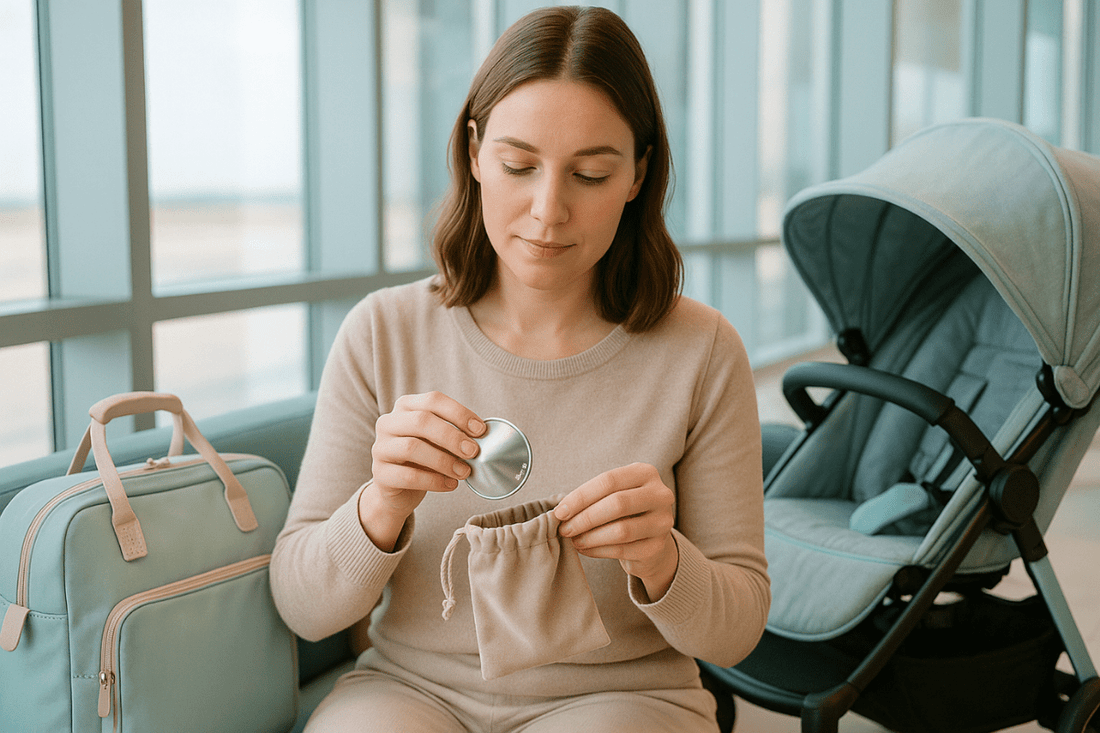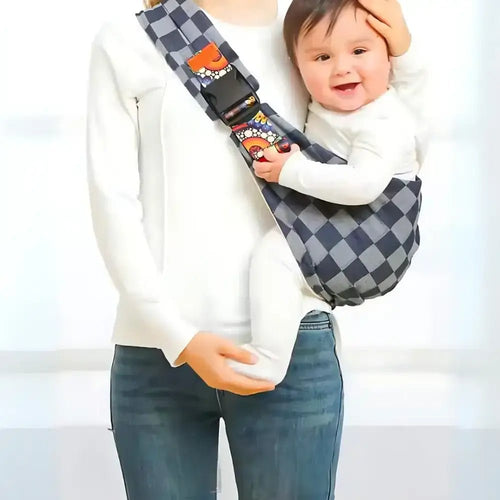
Travel Breastfeeding Tips: Practical Guidance for Moms on the Go
Traveling with a breastfeeding baby? It’s no small feat. Sore nipples, leaks, and disrupted routines can all show up uninvited. But you can make it work—and even stay comfortable—by planning ahead and packing a few practical tools.
One of my favorite low-effort helpers: silver nursing cups. They slip right over sore nipples between feeds, offering gentle protection and a break from rubbing fabrics. Honestly, anything that makes feeding on the go less stressful is worth a spot in your bag.
Travel means shifting environments and unpredictable schedules. Feeding on demand keeps your supply steady, and staying hydrated helps with both milk and energy. If you’re flying, feeding during takeoff and landing can relieve your baby’s ear pressure—it’s a small trick, but it works.For more professional insights, see ACOG’s breastfeeding guidance.
A comfy baby carrier frees up your hands and lets you move through airports or train stations with less hassle. For night feeds or long car rides, a portable bottle warmer makes life so much easier.
Here’s the bottom line: with a bit of prep and a few handy tools, you’ll feel more confident and comfortable traveling with your baby. You’ve got this.UNICEF also shares great tips for parents on the go in their parenting resources. For more breastfeeding-friendly gear, check our postpartum essentials collection.
Key Takeaways

- Thoughtful prep makes breastfeeding on the go easier and more comfortable.
- Feeding on demand and protecting sensitive skin supports both supply and comfort.
- Travel-friendly tools like silver nursing cups and bottle warmers add flexibility.
soothing silver nursing cups
portable bottle warmer for travel
ergonomic baby carrier
Essential Planning for Travel Breastfeeding Success
Traveling with a nursing baby can bring up all sorts of new challenges. Sore nipples, leaks, and irritation are common, especially when you’re out of your comfort zone.
Comfort matters, and so does having the right gear. Knowing how to handle both fresh and frozen breast milk keeps feeding safe and less stressful. A little planning goes a long way.
Packing Breastfeeding Gear for Travel

Let’s talk about what to pack. Nursing pads help absorb leaks and prevent irritation—soft, reusable ones are gentle and easy to swap out. Toss in a nursing cover or scarf for privacy if you want it.
Bring a portable breast pump, especially for longer trips. Electric pumps need adapters, so keep a manual pump handy too in case you can’t find an outlet. Don’t forget extra pump parts, cleaned and packed in sealed bags.For scientific updates on breastfeeding, check the NCBI library.
Other helpful items:
- Comfy nursing bras or tanks
- Silver nursing cups for soothing between feeds
- Clean storage bags or containers for milk
Packing thoughtfully means you’ll feel more prepared and less frazzled when you’re away from home.You can also browse Mother & Baby’s guides for practical advice.
Storing and Transporting Fresh Breast Milk
Keeping breast milk safe is all about temperature and cleanliness. Use clean, food-grade containers or sealed milk bags. Store milk in the coldest part of the fridge—usually the back.
For trips up to 24 hours, a cooler with frozen ice packs works well. Arrange the milk and packs so everything stays cold. If you can, check the temperature now and then.
At the airport, you’re allowed to bring as much breast milk and supplies as you need. Let TSA know at the start of screening for a smoother process. They might X-ray the milk, but it’s considered safe.
Traveling with Frozen Breast Milk
Frozen milk takes a bit more effort. Use a well-insulated cooler with frozen gel packs to keep it solid. If there are still ice crystals, you can refreeze it when you arrive.The WIC breastfeeding portal offers helpful resources on milk storage.

Once it’s fully thawed, stick it in the fridge and use it within 24 hours. Don’t refreeze milk that’s completely thawed. Label every container with the date you expressed the milk.
Services like Milk Stork can ship frozen milk for you, keeping it cold the whole way. That’s a lifesaver if you’re on a long trip and carrying it yourself isn’t realistic.
Feeding Your Baby While Traveling
Feeding your baby on the go isn’t always easy. You might deal with sore nipples, leaks, or a lack of private spaces. Having a plan—and a few tricks up your sleeve—can make all the difference.
Managing milk supply, finding places to feed, and handling equipment might feel overwhelming at first. But with a little practice, you’ll find your rhythm.
Breastfeeding in Public with Confidence
Worried about nursing in public? You’re not alone. Choose tops with easy access—nursing shirts or stretchy tees save time and hassle. If you want privacy, a lightweight cover works, but honestly, it’s totally your call.
Quiet corners, family restrooms, or nursing rooms can help if you’re feeling shy. Keeping a good latch and switching positions can prevent soreness. Soft breast pads handle leaks and keep your clothes dry.
Don’t forget to drink water and take a breath—relaxing helps your milk flow. If you know where the nursing rooms or family spaces are ahead of time, you’ll feel more at ease.For trusted advice, see the NHS breastfeeding guide.
Exclusively Pumping on the Road
If you’re exclusively pumping, you’ll need to plan a bit more. Pack a portable pump and clean storage bags or containers. Pumping regularly keeps your supply steady and avoids painful fullness.
Hand expressing is a good backup if you can’t use your pump for some reason. A cooler bag with ice packs is a must for keeping milk safe until you reach a fridge.For more parent-tested advice, explore Parents magazine.

Wipe down pump parts between uses with travel sanitizers or wipes. Try to stick to your usual pumping schedule, even if you’re on the move. And always pack extra batteries or a charger for your pump.
Using a Portable Bottle Warmer
A portable bottle warmer is a real convenience when you’re away from home. These warmers heat milk gently to the right temp—no hot spots, no lost nutrients.
Battery or USB-powered warmers fit right into your diaper bag. Go for one with easy controls and quick heating. If you’re in a pinch, a small thermos with hot water can do the trick.
Always check the milk’s temperature before feeding. And keep your warmer clean and dry so it lasts.For additional health-based guidance, check Women’s Health breastfeeding resources.
For more tips, the CDC’s Travel and Breastfeeding guide is a solid resource.
Managing Health, Safety, and Comfort on the Go
Traveling with a nursing baby—or while exclusively pumping—can throw some curveballs your way. Discomfort, milk storage dilemmas, and surprise delays happen. Staying organized helps you handle whatever comes up.
Maintaining Breast Milk Supply During Trips
To keep your milk supply steady, try to stick to your usual feeding or pumping schedule. Pump or nurse as often as you would at home, even if it feels tricky.
Adapters make electric pumps easier to use on the go, but manual or battery pumps work fine if you’re somewhere without power. Nursing or pumping during flights can also prevent soreness and help your baby’s ears adjust to pressure changes.
Store milk in insulated cooler bags with ice packs for up to 24 hours. Once frozen milk thaws, use it within a day and don’t refreeze if it’s completely melted. If you can, ask about fridge space at your hotel or rental before you arrive.
Sanitizing Breast Pump and Supplies
Clean pump parts keep your baby safe. Wash your hands with soap and water or use a 60% alcohol hand sanitizer before pumping.
After each use, clean all parts that touched milk. If you can’t get to a sink, use sterile wipes designed for pump parts. Bring extra BPA-free storage bags or containers with tight seals.
Let everything air dry on a clean towel. Pack dry pump pieces in a clean, airtight bag to avoid germs.The Breastfeeding Network offers more cleaning and hygiene tips.
Portable UV sanitizers or sterilizing bags are handy if you want to skip boiling water or don’t have access to a kitchen. They’re a real time-saver when you’re on the move.

Preparing for Emergencies and Unexpected Delays
Travel rarely goes exactly as planned. Missed flights or traffic jams can throw off your feeding routine.
Pack extra milk storage bags, pump batteries, and hand sanitizer. It’s smart to have a backup manual pump or know how to hand express in case your electric pump fails. Frozen expressed milk is a good backup if you’re separated from your baby.
Look up local lactation consultants or clinics at your destination, just in case. Apps or support contacts can help if you hit a snag with soreness or supply.
Try to rest and drink water when you can. Comfort items like nursing pads or silver nursing cups can help prevent chafing and absorb leaks if your schedule gets thrown off.
Frequently Asked Questions
Traveling while breastfeeding brings up plenty of questions—about comfort, storage, and keeping routines, especially if you’re away from your baby. Here are some quick answers to the most common concerns.
How can I comfortably breastfeed while traveling by car or plane?
Wear clothes that are easy to adjust—think nursing tanks or button-downs. A scarf or nursing cover can add privacy if that helps you relax.
On planes, nursing during takeoff and landing helps your baby’s ears. In the car, take breaks to nurse so you don’t get uncomfortably full.
What are the best strategies for storing and transporting breast milk during travel?
Express milk into clean, BPA-free containers or milk bags with tight lids. Use an insulated cooler bag with frozen ice packs to keep milk cold for up to 24 hours.
As soon as you arrive, put the milk in a fridge or freezer.
What should I consider when traveling internationally with a breastfed baby?
Think ahead about time zones, feeding schedules, and where you’ll be able to nurse or pump. Research local resources like breastfeeding lounges or lactation support.
Bring extra supplies—hand sanitizer, backup pumps, and storage containers. It’s also smart to check customs rules about bringing milk and gear.
How can I maintain my breastfeeding routine while on a trip without my baby?
Pump or express milk regularly to keep your supply steady. An electric pump usually works best, but a manual pump is a good backup.
Reach out to a lactation consultant or your pediatrician if you need personalized advice. Knowing how to hand express can also be a lifesaver if your equipment fails.For expert-backed strategies, see KellyMom’s breastfeeding articles.
Are there specific airline policies regarding traveling with breast milk that I should be aware of?
The TSA lets you bring all the breast milk, ice packs, and pumping equipment you need through security. Breast milk isn’t subject to the usual liquid limits.
Let TSA agents know you have milk and supplies at the start of screening. You can ask for your milk not to be X-rayed, though you might get extra screening.
What are the guidelines for keeping pumped breast milk safe during long-haul travel?
You’ll want to keep freshly expressed milk cool in an insulated bag with frozen packs. This setup usually keeps milk safe for up to 24 hours.
If your milk is still partially frozen or has ice crystals, you can refreeze it when you arrive. Thawed milk needs to go in the fridge and should be used within 24 hours.
Check the milk’s temperature and look for any changes while you’re on the move. It’s a bit of extra effort, but it helps keep things safe for your little one.

Need more details? The CDC has a handy page on traveling with breast milk.
Still have questions about silver nursing cups or breastfeeding?
Visit our FAQs for quick answers

